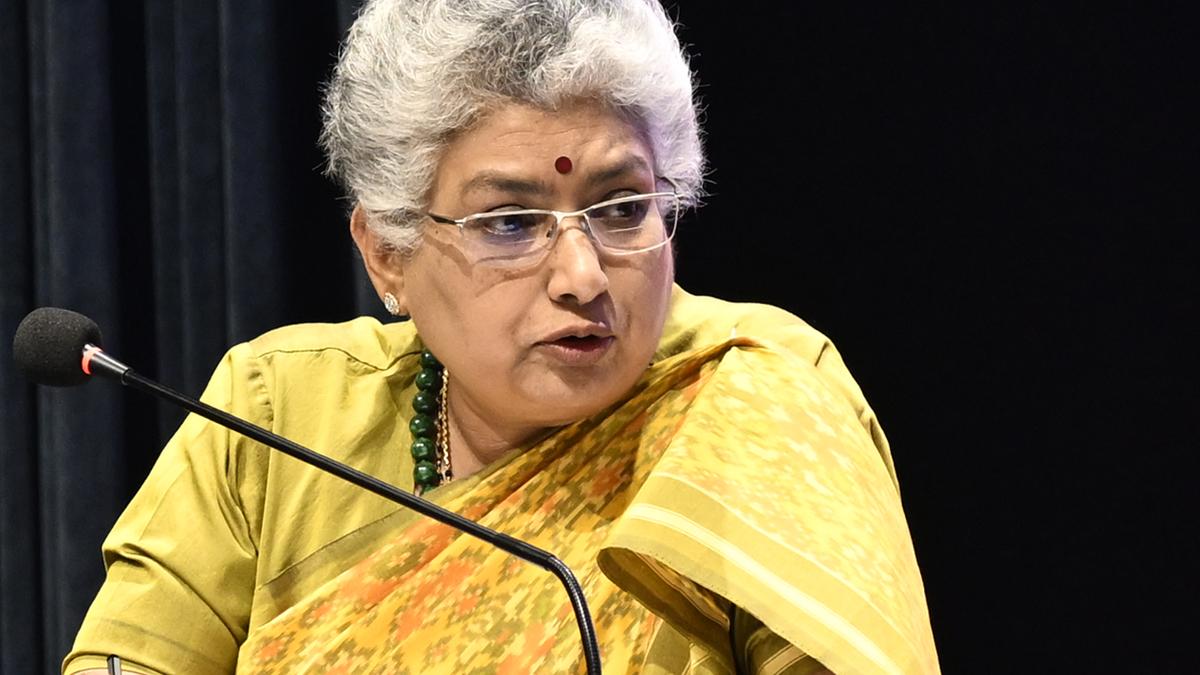News
Udhayanidhi Stalin Appointed Deputy Chief Minister of Tamil Nadu: A New Era Begins

In a significant political development, Udhayanidhi Stalin, the son of Tamil Nadu’s Chief Minister MK Stalin, is set to be sworn in as the Deputy Chief Minister of Tamil Nadu on September 29, 2024. This appointment marks a pivotal moment in the political landscape of the southern state, as the younger Stalin ascends to a higher leadership role. Udhayanidhi Stalin’s promotion to the post of Deputy Chief Minister comes as the Dravida Munnetra Kazhagam (DMK) party aims to strengthen its position ahead of the upcoming elections and ensure continuity in governance. His political journey has been closely watched, and his new role is expected to bring a fresh perspective to the state’s administration.
Political Background of Udhayanidhi Stalin
Udhayanidhi Stalin is not new to politics. Coming from a family with a rich political legacy, he has followed in the footsteps of his grandfather M. Karunanidhi, one of Tamil Nadu’s most iconic leaders. Udhayanidhi made his entry into politics through the DMK, the party that his family has led for decades. He has been serving as the Minister for Youth Welfare and Sports Development in Tamil Nadu’s current cabinet. Over the past few years, his involvement in politics has gradually increased, showing his capability in governance and leadership.
Udhayanidhi’s rise within the DMK has been both swift and calculated. Known for his charismatic appeal among the youth and his strong connection with the party’s grassroots supporters, he has become a prominent face of the DMK. His political career took a significant leap when he contested and won the Chepauk-Thiruvallikeni constituency in the 2021 Tamil Nadu Legislative Assembly elections. His performance as a minister has been generally well received, making him a natural choice for the higher responsibility of Deputy Chief Minister.
Why Udhayanidhi Stalin’s Appointment Matters
The appointment of Udhayanidhi Stalin as Deputy Chief Minister is not just a routine political move; it signals a strategic shift for the DMK. This decision is seen as a way to ensure the smooth transition of leadership in the state and prepare Udhayanidhi for a larger role in Tamil Nadu’s political future. With MK Stalin at the helm as Chief Minister, the party has been focused on consolidating its leadership and securing the trust of the people for long-term governance.
As Deputy Chief Minister, Udhayanidhi will likely play a more significant role in the day-to-day administration of the state, sharing the responsibilities with his father. This move also positions him as a potential successor to MK Stalin, further cementing the family’s political dynasty in Tamil Nadu. For the DMK, which has always had a family-centric leadership, this is a calculated step to ensure continuity and stability in the party’s leadership.
Key Challenges Ahead for Udhayanidhi Stalin
Despite the excitement surrounding Udhayanidhi Stalin’s appointment, he faces several key challenges. Tamil Nadu, like many other states, has its share of governance issues, economic challenges, and public demands. As the new Deputy Chief Minister, Udhayanidhi will have to address concerns related to unemployment, education, healthcare, and industrial development in the state. Moreover, the state’s relationship with the central government, led by the Bharatiya Janata Party (BJP), will also require careful navigation.
One of the primary areas where Udhayanidhi will need to focus is the youth and employment sector. Tamil Nadu has a large youth population, and addressing unemployment and providing educational opportunities will be crucial to maintaining the DMK’s popularity among the younger generation. Additionally, ensuring the continuation of various welfare schemes initiated by the DMK government will be a critical aspect of his role.
The Significance of September 29th Swearing-In Ceremony
The swearing-in ceremony on September 29, 2024, will be a momentous occasion, symbolizing the start of a new chapter in Tamil Nadu’s governance. The event is expected to be attended by top political leaders, DMK supporters, and members of the public. For Udhayanidhi Stalin, this will be a defining moment in his political career, as he takes on greater responsibilities and steps into a more prominent leadership role. The ceremony is expected to be held at the Raj Bhavan in Chennai, with Governor RN Ravi presiding over the proceedings.
DMK’s Future Under Udhayanidhi Stalin
With Udhayanidhi Stalin stepping into the role of Deputy Chief Minister, the future of the DMK looks poised for transformation. The party has always been deeply rooted in the principles of social justice, welfare schemes, and Tamil identity, and Udhayanidhi is expected to continue these policies. However, his leadership style will be closely watched to see how he adapts to the evolving political and social landscape of Tamil Nadu.
Udhayanidhi’s ability to balance the demands of governance, party leadership, and the expectations of the public will determine the trajectory of his political career. His appointment is a clear signal that the DMK is preparing for the future, with Udhayanidhi playing a central role in its strategy. The coming months will be crucial in defining how effectively he can manage the dual responsibilities of governance and leadership within the DMK.
Conclusion
The appointment of Udhayanidhi Stalin as Deputy Chief Minister of Tamil Nadu marks a critical juncture in the state’s political history. As the son of Chief Minister MK Stalin, Udhayanidhi’s rise to power has been a calculated and strategic move by the DMK to ensure continuity in leadership and governance. While the road ahead is filled with challenges, his past performance as a minister and his connection with the people make him a strong contender for future leadership in the state.
The swearing-in ceremony on September 29, 2024, will be a pivotal moment, setting the stage for Udhayanidhi’s future role in shaping the destiny of Tamil Nadu.
News
Supreme Court Judicial Critique and the Legacy of Justice Krishna Iyer

The Indian judicial system has long been renowned for its dedication to justice, fairness, and legal principles. Central to this system is the Supreme Court of India, a pillar of integrity where justices weigh the nation’s most pressing legal concerns. Recently, discussions have intensified around the remarks made by Chief Justice of India (CJI) concerning Justice V.R. Krishna Iyer. As one of the most influential judges in India, Krishna Iyer’s legacy continues to shape the judiciary, though not without criticism. Here, we delve into the CJI’s criticism of Krishna Iyer, examining its context, impact, and implications for judicial independence and accountability.
Understanding the Context: Supreme Court Dynamics
The Role of the Supreme Court Bench and Judiciary Dynamics
The Supreme Court functions on the foundational principle of checks and balances. Composed of a nine-judge bench, the Supreme Court’s duty is to interpret the Constitution, uphold civil liberties, and ensure the government’s actions align with legal standards. Given the diversity in judicial philosophy and interpretive approaches among justices, critical exchanges are not uncommon. However, it is rare for a Chief Justice to publicly question the approach of a former judge of such standing as Justice Krishna Iyer.
Judicial Independence: A Cornerstone of Democracy
Judicial independence remains critical to safeguarding democratic principles, preventing undue influences from swaying the course of justice. This freedom allows judges to interpret laws based on the Constitution, immune to external pressures. Any perceived attack on the legacy of a judge as notable as Justice Iyer raises concerns about institutional respect and unity within the judiciary.
Justice Krishna Iyer’s Judicial Legacy and Philosophy
Social Justice Advocate
Justice V.R. Krishna Iyer, a towering figure in Indian law, was known for his progressive judgments and advocacy for marginalized communities. He championed human rights and voiced strong opinions on social justice. His judgments sought to democratize access to justice, and he used his position to protect individual liberties, particularly for underrepresented communities.
Notable Judgments by Justice Krishna Iyer
- Maneka Gandhi v. Union of India – Justice Iyer expanded the scope of personal liberty under Article 21, a landmark interpretation that fundamentally shaped Indian jurisprudence on fundamental rights.
- Bachan Singh v. State of Punjab – In this case, Iyer’s dissent played a crucial role in capital punishment debates, promoting a reformist perspective that continues to influence judicial thinking.
- Govind v. State of Madhya Pradesh – His interpretation in this case broadened the concept of privacy rights, laying the groundwork for future privacy-related judgments.
Justice Iyer’s philosophy centered around constitutional morality, balancing individual rights with societal needs. His dissenting opinions often reflected his commitment to human dignity and egalitarian principles.
The Chief Justice’s Criticism and Its Implications
Evaluating the Criticism
The recent comments by the Chief Justice of India regarding Justice Iyer’s judgments have sparked considerable debate. This critique, which suggests that some of Iyer’s judgments may have exhibited judicial overreach or activism, raises questions about the extent to which judges should interpret the law versus strictly adhering to the letter of the Constitution.
Justice Iyer’s judgments often pushed traditional boundaries, and the CJI’s remarks reflect an ongoing debate over judicial activism. While some view activism as essential to addressing societal inequalities, others argue that it risks politicizing the judiciary.
Impact on Judicial Integrity and Public Perception
Criticizing a former justice in such a manner can influence public confidence in the judiciary. As guardians of justice, Supreme Court judges are expected to maintain collegiality and mutual respect. When a Chief Justice publicly questions a former judge’s approach, it can lead to perceptions of discord within the judiciary, potentially eroding trust in the institution’s objectivity and impartiality.
Moreover, it may impact future interpretations of Justice Iyer’s judgments, leading to re-evaluations or more conservative readings of social justice issues that he ardently championed.
Judicial Activism vs. Judicial Restraint: A Delicate Balance
What is Judicial Activism?
Judicial activism refers to judges shaping policy through their rulings, often filling in legislative gaps or interpreting laws in a manner that addresses pressing social issues. Justice Iyer epitomized this approach, believing that law should serve social welfare and human dignity. However, judicial activism has its critics who argue that it infringes on legislative authority.
Judicial Restraint: An Alternative Approach
Judicial restraint emphasizes minimal judicial interference, urging judges to interpret laws strictly according to the Constitution. Advocates argue that it maintains separation of powers and prevents the judiciary from assuming a legislative role. The CJI’s recent comments may reflect a preference for this conservative approach, valuing constitutional literalism over moral interpretation.
The Debate in Modern Context
As society progresses, so do the legal challenges that emerge. Issues such as privacy rights, digital freedoms, and gender equality require interpretations that evolve with societal norms. The judiciary is often tasked with finding a balance that addresses modern issues without overstepping its role. Justice Iyer’s activism remains relevant, reminding us that the law must adapt to changing times, while the CJI’s critique calls for caution in judicial expansion.
The Importance of Constructive Judicial Discourse
Healthy Debate Within the Judiciary
While such public criticism might seem controversial, it also underscores the value of open debate within the judiciary. Disagreements allow the judiciary to reflect on its own practices and ensure that legal interpretations remain consistent with constitutional values.
Strengthening Judicial Accountability
Criticism among judges can enhance judicial accountability, prompting judges to carefully consider the far-reaching implications of their rulings. By fostering a culture of scrutiny, the judiciary can become more self-aware and committed to its responsibility toward citizens.
Long-Term Implications for Future Judgments
The CJI’s remarks may influence how future judges approach cases, particularly those involving social justice and constitutional interpretations. Future benches may lean towards a more conservative application of law, potentially affecting the legacy of progressive judicial interpretation.
Conclusion: Upholding the Spirit of Justice in a Changing World
Justice Krishna Iyer’s contribution to the judiciary cannot be overstated. His legacy embodies a vision of inclusive justice, where the rights of individuals are safeguarded, and social equity is prioritized. The Chief Justice’s recent critique does not negate this legacy but instead highlights the judiciary’s ongoing dialogue on judicial philosophy and interpretive boundaries. For India’s judiciary to continue serving its constitutional mandate, it must find the right balance between restraint and activism—a dynamic that will ultimately shape the country’s legal landscape.
News
Reliance Jio’s 2025 IPO: A Potential Milestone in Indian Market History

Reliance Jio, one of India’s largest telecommunications giants led by Mukesh Ambani, is gearing up for an IPO (Initial Public Offering) in 2025. With a market-shaking potential, the upcoming Reliance Jio IPO is anticipated to be India’s largest IPO to date. This bold move follows the success of Reliance Jio in transforming India’s telecom and digital service landscape, and the IPO could drive substantial capital investment into the country’s fast-growing tech ecosystem.
What Sets Reliance Jio Apart?
Reliance Jio has revolutionized digital access in India. From its inception, Jio has redefined connectivity for millions, delivering affordable internet access and advanced telecommunication services. Its broad user base and cutting-edge infrastructure make it a strategic player in India’s digital growth. The brand’s 5G rollout and strong digital footprint uniquely position it to attract investors in one of the world’s most dynamic telecom markets.
The Anticipated Scale of Reliance Jio’s IPO
Jio’s IPO aims to raise billions, with reports suggesting it could exceed the size of previous major Indian IPOs. Market analysts predict the IPO may set records, given Reliance Jio’s strong market position, substantial user base, and continual expansion across digital platforms. The raised capital will likely fund further advancements, positioning Jio to expand its services and influence within and beyond the telecom industry.
Potential Impact of the Reliance Jio IPO on the Stock Market
The Jio IPO could boost investor interest in the Indian stock market, drawing both domestic and international investors. Historically, Reliance Industries’ strategic moves have impacted broader market trends, and Jio’s IPO could stimulate significant market activity, benefiting various stakeholders across sectors.
Investor Interest and Strategic Partnerships
Given its extensive user base, advanced technology, and scalable digital platforms, Reliance Jio is expected to attract interest from both institutional and retail investors. Additionally, strategic partnerships with global tech firms may enhance Jio’s appeal to investors seeking exposure to India’s growing digital economy.
How Will the IPO Strengthen Reliance Jio’s Vision?
Reliance Jio’s IPO will likely provide the capital needed to accelerate its mission of digital empowerment in India. With a robust infrastructure and an expanding 5G network, Jio is focused on leveraging its resources to enhance connectivity and digital solutions. The IPO proceeds may further support Jio’s ventures in areas like cloud services, IoT, AI, and digital content.
Preparing for an Historic Market Debut
Reliance Jio’s IPO represents not just a financial event but a significant milestone in India’s digital journey. Investors and market analysts are watching closely as the company prepares for a potential landmark IPO that could reshape both the tech and telecom landscapes.
News
Elcid Investments: A Historic Surge in Share Price

On October 29, 2024, Elcid Investments made headlines by overtaking MRF to become India’s most expensive stock. This remarkable feat was largely driven by a BSE auction aimed at price discovery for holding companies, resulting in each share of Elcid being valued at an astonishing Rs 2.25 lakh. In a dramatic twist, the smallcap stock saw its price skyrocket from a mere Rs 3.53 to an incredible Rs 2,36,250 in a single trading day—a staggering increase of 66,92,535%. Meanwhile, MRF shares closed the day at Rs 1.22 lakh, marking a 0.61% decline.
This article will delve into the factors contributing to this unprecedented rise in Elcid’s stock price, the broader implications for the Indian market, and what this means for investors and market participants.
Understanding Elcid Investments
Elcid Investments is a registered non-banking financial company (NBFC) categorized under investment companies by the Reserve Bank of India (RBI). The firm does not operate any business of its own; rather, it focuses on investments in other companies, boasting a diverse portfolio that includes significant stakes in industry giants like Asian Paints. Its primary revenue source is the dividends generated from these holdings, alongside a notable investment portfolio worth over Rs 11,000 crore.
The Role of the BSE Auction
The surge in Elcid’s share price can be attributed to a special auction conducted by the Bombay Stock Exchange (BSE) on October 28, 2024. This auction was part of a broader initiative spearheaded by the Securities and Exchange Board of India (SEBI) to enhance price discovery mechanisms for investment companies (ICs) and investment holding companies (IHCs).
Historically, many of these firms traded significantly below their book values, creating a disconnect between market perception and underlying asset values. To rectify this, SEBI introduced a framework for “special call auctions with no price bands,” designed to improve liquidity and investor interest in these stocks. The auction resulted in a price discovery that set the opening price for Elcid at Rs 2.25 lakh on October 29, a value still considered below its intrinsic book value.
The Market Reaction
The announcement of Elcid’s new price immediately sparked interest and disbelief among market participants. Social media platforms, particularly X (formerly Twitter), became abuzz with reactions as traders and investors processed the shocking leap in valuation. Many expressed astonishment at the rapid transformation of Elcid from a low-priced stock to one of the most valuable in the market.
This dramatic rise raises critical questions about valuation methodologies and market behavior. Investors often look for indicators of a stock’s worth, including earnings reports, dividend yields, and market sentiment. The BSE auction method, particularly one without price bands, is relatively new and brings both opportunities and risks.
Financial Performance and Growth
Elcid’s financial performance has shown promise, particularly in the June quarter of 2024. The company reported a net profit of Rs 135.95 crore, reflecting a substantial increase of 39.57% from Rs 97.41 crore in the same period the previous year. Additionally, net sales were recorded at Rs 177.53 crore, a 38.28% growth compared to Rs 128.38 crore in June 2023.
Such robust financial metrics, combined with the company’s extensive investment portfolio, play a crucial role in its newfound valuation. As Elcid continues to receive dividends from its various investments, its financial health appears to be on a strong upward trajectory.
Investment Implications
The meteoric rise of Elcid Investments offers several lessons and implications for investors:
- Volatility and Speculation: The sheer scale of Elcid’s price movement underscores the volatility that can occur in the stock market, especially with smallcap stocks. While such dramatic increases can yield significant short-term profits, they also carry substantial risks. Investors must conduct thorough due diligence before entering the market, especially in cases of extreme price volatility.
- Value Investing vs. Speculative Trading: The disparity between Elcid’s auction price and its book value invites discussions about value investing versus speculative trading. While some investors may seek to capitalize on rapid price changes, others may prefer to invest based on long-term fundamentals and intrinsic value.
- Regulatory Influence: SEBI’s intervention in price discovery showcases the importance of regulatory frameworks in maintaining fair market practices. The auction method could be a model for future initiatives aimed at improving liquidity and investor confidence in various sectors.
- Portfolio Diversification: Elcid’s focus on investments in established companies like Asian Paints serves as a reminder of the benefits of diversification. Investors are encouraged to spread their investments across different sectors to mitigate risks associated with individual stocks.
The Future of Elcid Investments
With its recent price surge, Elcid Investments has positioned itself as a significant player in the Indian stock market. However, sustaining such a high valuation will depend on several factors, including continued performance of its investments, market conditions, and regulatory developments.
As of now, the company’s valuation is still below its book value, indicating potential for further upside if it continues to grow its investment portfolio effectively. The company’s approach to managing its holdings and generating returns through dividends will be closely monitored by investors.
Broader Market Implications
Elcid’s rapid ascent is not just a story of one company’s success; it reflects broader trends in the Indian market. The dramatic shifts in stock prices serve as a reminder of the potential for sudden changes in investor sentiment, which can lead to equally rapid declines as seen in many speculative bubbles.
Furthermore, Elcid’s rise may encourage other smallcap and midcap companies to reevaluate their pricing strategies and consider engaging in similar price discovery auctions. This could lead to a more dynamic market landscape, where the focus shifts toward more transparent and fair pricing mechanisms.
Conclusion
Elcid Investments’ phenomenal journey from obscurity to becoming India’s most expensive stock exemplifies the unpredictable nature of the stock market. It highlights the importance of regulatory frameworks in shaping market dynamics and investor behavior. While the company’s recent financial performance has been encouraging, the future remains uncertain as it navigates the complexities of the market.
Investors and market participants must remain vigilant, recognizing the inherent risks and opportunities presented by such volatile stocks. As Elcid continues to make waves on Dalal Street, its story serves as both an inspiration and a cautionary tale for those looking to make their mark in the world of finance.

 Celebrity2 months ago
Celebrity2 months agoKim D’Estainville: A Brief Biography of a Distinguished Media Executive

 Celebrity2 months ago
Celebrity2 months agoWho is Josh Gates’ Daughter? A Look Into the Family Life of the Famous Explorer

 Celebrity3 months ago
Celebrity3 months agoSamay Raina Biography

 Celebrity2 months ago
Celebrity2 months agoMikki Mase Net Worth 2024: The Rise of a Gambling Maverick

 Celebrity4 months ago
Celebrity4 months agoLove Kataria Biography

 Sports3 months ago
Sports3 months agoSimone Biles Biography

 Celebrity3 months ago
Celebrity3 months agoLeAnn Rimes to Shake Things Up at “The Voice Australia” 2024

 Celebrity2 months ago
Celebrity2 months agoDDG Net Worth: The Rise of a YouTube Star-Turned Rapper
















